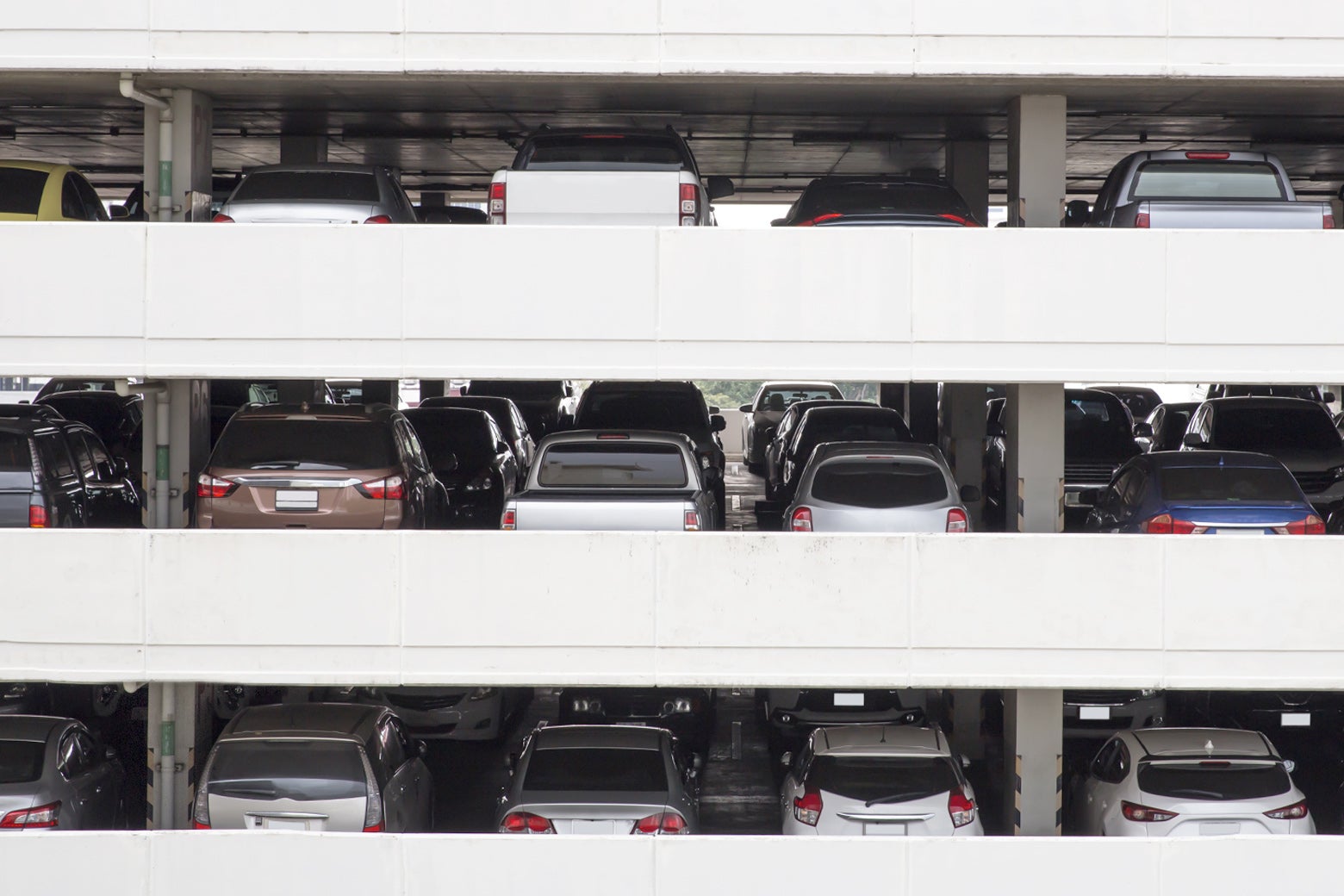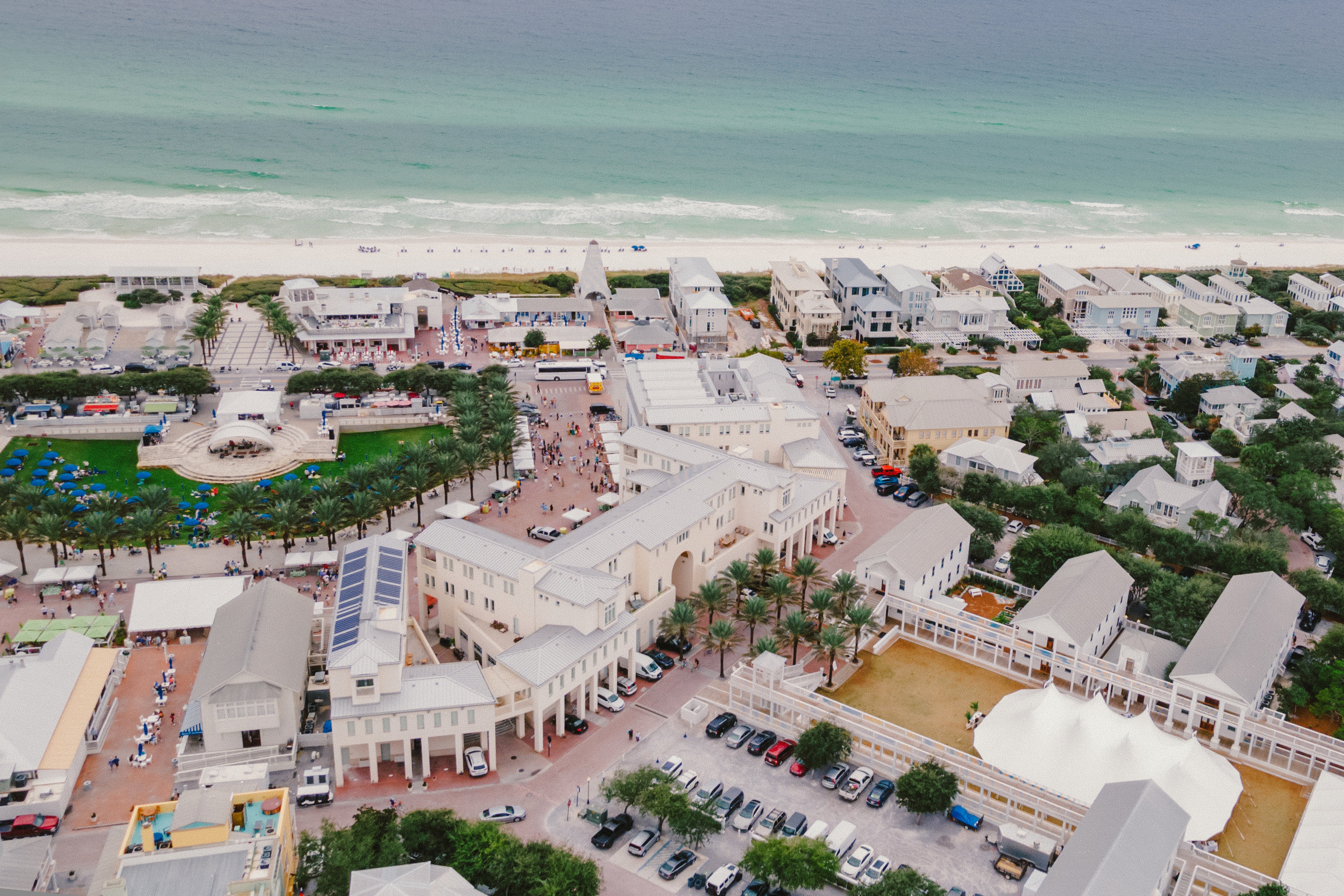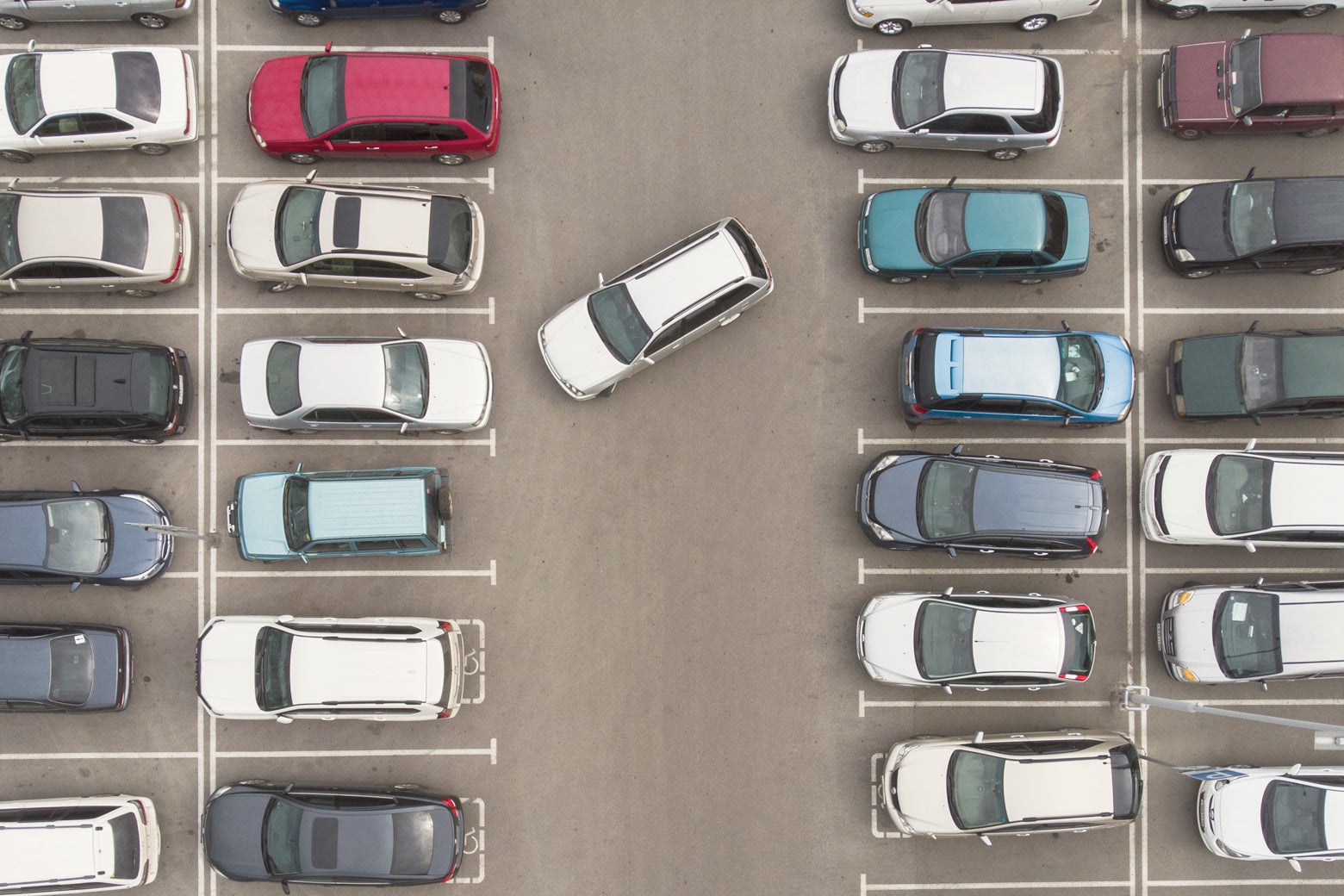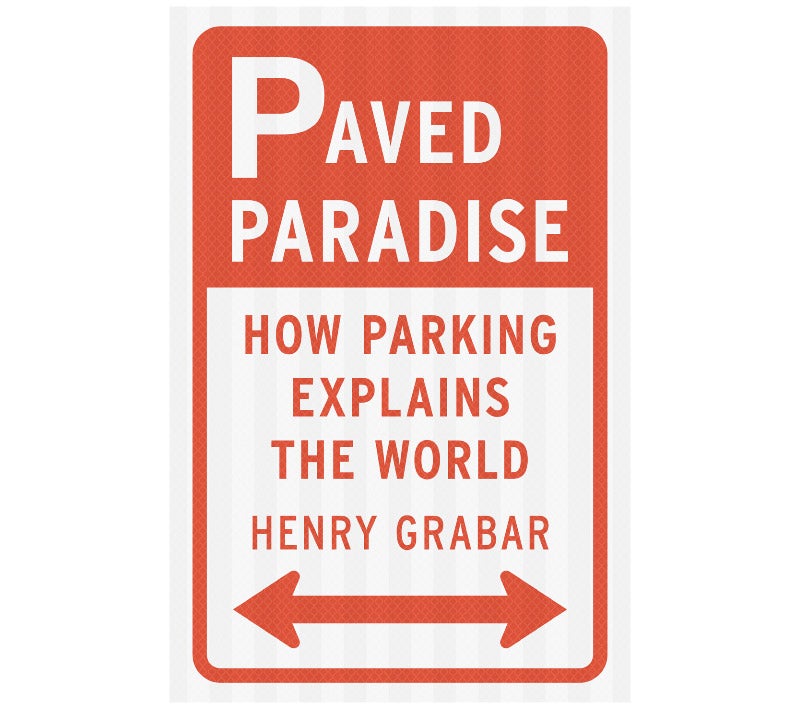This article is adapted from an episode of Decoder Ring, Slate’s podcast about cracking cultural mysteries, as well as the book Paved Paradise: How Parking Explains the World.
Once you see it, it can’t be unseen: the astonishing amount of land this country has devoted to storing cars. In many large downtowns, more than a quarter of properties are used exclusively for parking. This does not count garages nested inside hotels, apartment buildings, and office towers. And it does not count the many miles of curb used for parking.
In 2013 the lead designer of SimCity was asked what, in his team’s measurements of real-world cities, produced the biggest surprise. “Parking lots,” he responded. “We were originally just going to model real cities, but we quickly realized there were way too many parking lots in the real world and that our game was going to be really boring if it was proportional in terms of parking lots.”
Places that are mostly parking are boring. There are likely between 1 and 2 billion parking spaces in this country, enough to pave a small state. That comes out to a handful of spaces for each car, and the ratio is even higher in cities: Seattle, for example, has five spaces for every household. Des Moines has 20 per household. A study of 27 mixed-use U.S. neighborhoods concluded that parking was, at peak times, oversupplied by 65 percent. Among neighborhoods with self-proclaimed “parking shortages,” the oversupply was still 45 percent.
So if there’s all this parking, why is it so hard to find a damn spot? How do we square this demonstrated parking abundance with the nagging hunch that continues to inspire it: that parking remains too difficult to find? Put another way, how do we break the cycle in which a perceived parking shortage requires us to deform our architecture, demolish our historic neighborhoods, and surrender our public space to satisfy the parking gods?
This question came up again and again in my research for my book Paved Paradise: How Parking Explains the World, and I encountered a few convincing hypotheses. Maybe our easy parking experiences wash over us, but our difficult parking hunts and steep parking tickets leave a lasting impression. Another theory for our fixation with parking is that it’s not included in driving directions, so it feels like a surprise imposition at the end of the trip. Perhaps both these frustrations can be folded into a bigger idea, which is simply that we have absurdly high expectations for parking. We expect it to be very convenient, immediately available, and free. It would be unimaginable to hold any other good or service to this standard.
Decoder Ring: Why You Can’t Find a Damn Parking Spot
There are, indeed, many parts of the U.S. that have made parking plentiful and gratis, at great cost to the environment, the architecture, and the neighborhood. Yet in many other places—precisely those where it might be possible to live happily without a car—the fear of a parking shortage prevents us from achieving many of the things we say we want, such as affordable housing, walkable streets, attractive design, and less traffic.
These are the kinds of places that hire Jane Wilberding, a Chicago-based parking consultant and a founder of the Parking Reform Network, with a clear complaint: We do not have enough parking. The solution is usually to blow a hole in the local budget by erecting a big new garage, which can cost as much as $100,000 per spot. That, Wilberding told me once, is like going straight to a hip replacement when a few bridges might have done the trick.
Wilberding says these clients are usually unhappy for the same three reasons, and not having enough parking isn’t one of them: “We undervalue parking, we don’t share parking, and we don’t tell people where it is.”
Let’s break those down. The simplest one to understand is that we don’t tell people where the parking is. The rules, meant to be legible from the window of a moving car, amount to long, complex logic problems that can take 4 vertical feet of signage to explain. Unlike at airports, malls, or sports stadiums, where parking access is clearly indicated, most American cities do a poor job of telling motorists where to leave their cars. This shouldn’t be a proud local secret. European cities, by contrast, usually have big, interactive signs directing drivers to garages the moment they enter town, complete with the number of available spaces.
Second: We don’t share parking. Much of the country’s parking abundance has been created through local zoning provisions called parking requirements, which mandate a minimum number of spaces for every conceivable land use, ranging from apartments to dirty bookstores to customhouses. Unfortunately, most jurisdictions don’t let buildings share this parking—even between complementary, adjacent uses like an office and an apartment building, or a courthouse and a theater. All this parking is Balkanized between private fiefdoms so patrons of one business’s parking lot can’t use the one next door.
Take churches, whose traffic is very spiky: They’re busy on Sunday mornings, but empty the rest of the week. So are their parking lots, which often sit empty even as nearby drivers go wanting. “If your enemies are hungry, feed them. If they’re thirsty, give them something to drink,” Wilberding says. “But if they ask to temporarily use some of your parking, don’t do it?”
Third, almost all of the country’s parking is free. As a result, commuters take the best spots first thing in the morning, and everyone who shows up later—whether to buy a dress, eat a hamburger, or deliver packages—gets stuck fighting for the scraps. In some cities, dank public garages (no one’s first choice) cost money, while street parking (everyone’s first choice) is free! It should be the opposite. Price the best parking, even just a little bit, and everyone falls into place. “The longer you’re staying at a particular destination, the more it makes sense to park a little bit of a distance away,” says Rachel Weinberger, a parking consultant, “because the extra travel to get you to the store is amortized over your workday.”
The consequences of this curious situation—parking, parking, everywhere, but not a spot for me—have been disastrous for American cities. More parking encourages more driving, by incentivizing car ownership, pushing locations farther apart, and impairing the creation of safe, efficient infrastructure for transit, bikes, and pedestrians. So, adding parking supply doesn’t necessarily make it easier to park, especially when that parking remains free, divided between uses, and hard to find. Until you build so much parking that there’s no longer anything worth driving to.

Focusing on demand for parking, on the other hand, can help resolve this conundrum. That has been one of the central insights of Donald Shoup, the parking scholar whose 2005 book The High Cost of Free Parking put a spotlight on America’s tragic obsession with parking supply. About a third of downtown traffic consists of drivers looking for parking. By pricing the curb correctly, Shoup argued, you could make that traffic vanish overnight. In the long term, you could avoid the cost of creating more parking and use the extra money to encourage people to carpool, use transit, or ride a bike. When San Francisco adopted Shoup’s pricing suggestions a few years ago, some streets did get more expensive—but other places to park, including the city’s public garages, got cheaper.
“I’m an optimist,” Shoup told me recently. “If we get things right with parking, and especially with moving cars as well, the world will be so much better. And parking is the easy thing to change.”
If you wanted to build a place to reduce parking demand, instead of increase parking supply, you might wind up with something like Seaside, Florida. The flagship development of the New Urbanism school of city planning, made famous among nonarchitects as the setting for The Truman Show, was born in the era of “peak oil,” and designed to be a rejection of the nation’s sprawling development patterns. “The waste of land is almost criminal,” Seaside founder Robert Davis wrote in 1989. “The waste of time and energy is an appalling drain on our human and natural resources.”
The town planners, architects Andrés Duany and Elizabeth Plater-Zyberk of the firm DPZ, designed Seaside to be a place where people would like to walk around. The houses are a handsome and diverse lot, running from traditional cottages to postmodern stunners by architects such as Aldo Rossi and Léon Krier. They’re on small lots, with front porches instead of back yards. There are almost no garages, or curb cuts, or concrete driveway aprons because people parallel park on gravel in front of their houses. They found a way to slow down traffic on the two-lane highway that runs through town that worked better than speed bumps, fines, or anything else. By parking along it! Public parking in town is clearly signaled. And relatively few people in Seaside have a parking spot that is exclusively theirs. As a result, public spots used by beachgoers during the day can be used by restaurant diners at night, and residential zone spots can be shared between households as residents and guests come and go.
As a result of this people-friendly planning, people in Seaside didn’t use the car that much. When DPZ was plotting out the next town down the coast, they sent an intern to survey Seaside. He found that Seasiders drove seven times a week—as opposed to making that many trips per day, a standard expectation for suburban households. “It’s not about eliminating cars; it’s about making parking inconvenient,” Duany said. “You don’t need to fall out of your kitchen into your car the way you do in suburbia.”
OK, big caveat: People with houses in Seaside drove only once a day. But thousands of people come to visit every day—to walk the streets, eat and drink downtown, and, of course, go to the beach. And for them, the first impression of Seaside is: a parking problem.
I was there on a weekday afternoon in February, and drivers told me they had done lap after lap after lap through the parking area, waiting for someone to pull out. You ain’t seen nothin’ yet, they told me: Spring break was coming, and parking would soon become truly “miserable.”

Robert Davis did not see this coming. “We didn’t really think it was going to be that much of a tourist attraction,” he told me. It’s hard to miss the irony: Seaside was supposed to be a place where people could forget their car and get around on foot. And precisely because of that, it became so popular it now has a serious parking problem. “It’s just crammed with cars,” said Micah Davis, Robert’s son and the head of the Seaside Development Corporation. He, too, had come to dread spring break. “The circling you thought was bad? It’s literally just a line of parked cars slowly moving down the street.”
Until, starting a few years ago, Seaside put Shoup into practice. The town made visitors pay for parking starting in March. In the high season, it charges dynamic pricing, with parking fees rising and falling depending on how crowded the lot is. The result, the Davises say, is a smoother parking experience for everyone—one that sorts visitors by how long they’re staying and, crucially, provides incentives for families to carpool, instead of having each teenager driving their own car. Too pricey? You can still park for free—just a little farther away.
And here’s the craziest thing. Because Seaside manages parking demand with shared, priced parking, it’s been able to do something that runs counter to half a century of American building patterns: reduce the parking supply.
A few blocks from the paid parking is Seaside’s Central Square. It’s a semicircular plaza lined with the town’s civic buildings: the post office, the bookstore, the record shop. In the center there’s a grassy lawn where kids play soccer.
It was also, until recently, a giant parking lot. During COVID, the Davises decided to turn it into a pedestrian plaza. Robert sent Duany a photo. “I always thought Seaside was a parking slum,” the architect reflected, “a strip shopping center with Steve Holl buildings. This plaza was one of the least favorite spaces I ever designed, because it was so full of cars. And one day COVID came, and it was so beautiful! It was the Cinderella of spaces.”
Paid parking had given the Davises the confidence to make a permanent move from parking lot to plaza. “The biggest help was that Donald Shoup wrote the High Cost of Free Parking, and we’d been studying it,” said Robert Davis. “When we eliminated about a third of our parking inventory, we weren’t panicked that our stores wouldn’t have customers, because we could manage by pricing it.” Sales receipts went up because the center of town was all dressed up for the ball.
Seaside is not your typical American city. It’s a vacation resort; the houses cost millions. But it’s not the only popular destination to find that the humble parking meter can decrease the number of cars that come, organize those that do, and fund public improvements besides.
Paved Paradise: How Parking Explains the World
By Henry Grabar. Penguin Press.
Slate receives a commission when you purchase items using the links on this page. Thank you for your support.
The biggest complaint is that it does not seem fair. I get why people hate paying for parking. Hunting for free parking is a pain in the butt, but it’s a level playing field, and a tax on the one thing we were all given in equal measure: time. Paying for parking feels like one more demand-driven pricing system in a world that’s increasingly full of them. Like paying for the best seat in a movie theater or paying to get on the plane first. As urban real estate prices make cities feel more and more exclusive, having a free parking spot feels downright egalitarian.
But free parking is fair only in the most superficial sense. There’s nothing fair about plumbers and delivery drivers racking up ticket after ticket because there’s nowhere to park. There’s nothing fair about all the toxic emissions from people cruising for parking drifting into nearby apartments. Nothing fair about the buses that run like molasses because of double-parked cars, or the cyclists who get hit because there are cars parked in the bike lane.
And as Shoup says, if you don’t make people pay for parking, you face the same dismal options that every U.S. city faced 50 years ago: Bulldoze your way to parking abundance, or force everyone to drive in circles and fight when a space opens up. Many people will think that a few dollars for a prime spot is worth it. And if they decide parking in a place like Seaside isn’t worth paying for? Well, then Seaside will simply lower the price.

